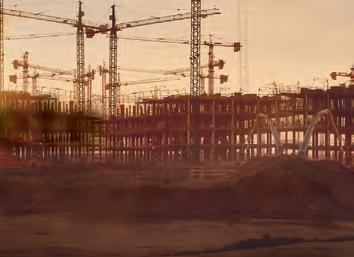
8 minute read
20 Years On Concrete
BY JONATHAN KOZLOWSKI, EDITOR


The concrete construction industry has changed a lot since the magazine officially launched in 2002. Let’s take a look back at some significant happenings these past two decades and look forward to concrete’s future.
Officially, the Concrete Contractor magazine was originally known as Concrete Concepts. The publication officially became the brand we know today in 2002 and has been celebrating concrete in all its forms since. To celebrate this, we invited a handful of industry insiders for their commentary on these two decades regarding significant changes and challenges—and asked for a bit of perspective on what the future holds.
EFFICIENCY
It’s safe to say that one of the most significant advancements in the last 20 years has been in technology and any useful improvements from technological upgrades should come hand-in-hand with an increase in efficiency. “Today’s technology is much more sophisticated, providing greater efficiency, flexibility, and ease of use,” says Keith Armishaw, North American Business Development Manager at Aquajet. Exemplifying the advancement in the technology of concrete construction equipment to increase the efficiency of today’s contractors, he points out that improvements in the Aqua Cutter 750V’s Infinity oscillation system helps contractors using hydrodemolition for the removal of concrete increase the bonding surface for concrete repairs but also reduce shadowing of the rebar and pipe holes.
Advancements in hydrodemolition coincides with a need for better wastewater management. As more environmental issues gained more awareness over the years, technology allowed contractors an increased efficiency with water treatment. “At first, contractors developed elaborate set-ups for collecting and treating wastewater, which was very laborious. In response to the need for an easier and more effective way to clean the water, Aquajet developed the EcoClear, a fully automated water treatment system. Once the water is treated, it is clean enough to be released into the environment or recirculated through the high-pressure pump. Both the robot and water treatment technology have majorly advanced the hydrodemolition segment and contractors’ ability to rehabilitate concrete structures over the last couple of decades.”
There have been also increased efficiencies at the cement plants with upgrades and making them more environmentally friendly. This effort changes the industry’s focus to reduce carbon emissions. The Portland Cement Association (PCA) launched its Roadmap to Carbon Neutrality in October 2021 and Mike Ireland, PCA President and CEO, has seen the changes made by companies already making a difference. “And they will continue to follow the guidelines provided in the Roadmap, which we’re confident will lead us to carbon neutrality by 2050. This is now our industry’s top priority.”
The research and development of lower-carbon cements, alternative fuels, and carbon capture technologies are all under continuous research and development. But to achieve the net-zero goal, the cement and concrete industry has to work together, says Ireland. “We
Adobe Stock Images | By C.Castilla
need everyone in the cement-concreteconstruction value chain to work with us. I also want to mention that Congress and state legislatures are part of this chain, too. PCA will continue to work with elected officials to help develop policies that will assist our companies in their R&D efforts. Effective, meaningful policies will enable us to continue to manufacture materials that are sustainable, durable, and better for the environment.”
Tim Nash, Director of Concrete Products at Wirtgen America has also seen efficiency at the core of the design of equipment as they respond to market changes. With more reconstruction projects and less new construction over the years, for example, he says that the integration of stringless control technologies, increased transportability of slipform pavers, and quicker paving width change times to address any paving run width changes. Changes to these machines have allowed change time to cost contractors hours instead of days.
Over the years, the company has continued its focus on improving smoothness and rideability along with a significant shift focusing more on sustainability, a reduced local emission output, and increased automation of various machine functions as a central theme addressing the shortage of skilled labor.
“In addition to a dwindling labor force, really the one of the biggest challenges has been the nature of the work,” says Nash. “Gone are the days of paving continuous runs all season long.
20 CONCRETE CONTRACTOR DECEMBER 2022
Jobs are cut up, different paving widths and often requiring constant moving of the paving equipment which can add significant time and cost to a project.”
LABOR & SAFETY
Undoubtedly, one of the largest impacts onto the construction industry has been the global pandemic. While many contractors were considered essential workers, the industry is still dealing with the adverse effects today. There is a great need for skilled labor but this shortage has been an issue for years prior to COVID—the global pandemic only exacerbated the situation. While private and public programs to increase training will help, PCA’s Ireland thinks that it will likely take some time for meaningful results to materialize.
The same way manufacturers like Wirtgen and Aquajet had made improvements to their machinery, throughout the past decade, contractors had to find innovative solutions to overcome a limited workforce as well as adapting to new health, safety, and environmental regulations.
“The industry as a whole is more aware, for example, of the effects of silica exposure,” notes Armishaw. “To help contractors protect the workforce, manufacturers have responded in a number of ways, such as developing dust suppression systems or incorporating remote operation. In our case, using water to remove concrete eliminates the dust, but we’ve had to help our customers find an efficient way to treat the blast water and meet environmental regulations.”
BUILDING SMARTER
The simple fact is that concrete is here to stay, even if the substance continues to evolve. Concrete mixes and how structures are built will need to change as materials become harder to source from depletion or cost.
“With greater awareness about sustainability, it’s possible structures will be designed with a longer life in mind,” says Armishaw. “Repair will then be an important aspect of extending the life of the structure, and repair procedures may be something that are considered during the design process.” Like Wirtgen’s increased integration of automation technologies, Armishaw also predicts that automated processes will affect safety by preventing strain and injury— adding to efficiencies throughout the jobsite.
Similarly, Ireland predicts the further digitalization of everything with a decrease in the reliance of paper. “Whether it’s paper delivery tickets, paper scheduling, blueprints,” he says. Even if you’re a small company with a dozen people or 300 on staff, software options are available to help to meet a contractors needs. Many of which are scalable and budget-freindly.
Further sustainable developments include 3D imaging and carbon capture systems. According to Ireleand there were currently (at the time of his response) four carbon-capture projects being funded currently by the Department of Energy—two of which are taking place at PCA member companies with more on the way.
“All aspects of construction will be quantified for carbon emissions both at the local level and up/downstream and could become significant parts of the bidding process and/or bonus incentive,” says Nash. Additional themes for the future of concrete construction include onsite crushing and reclamation of existing materials, and optimization from machine learning solutions not only at the paver but advancing the process such as batching, hauling, etc.
For the future of the Concrete Contractor magazine, readers can expect the continued coverage of projects and innovations within the concrete industry—in both the constructive and decorative arenas. We will reconvene our Top Products award program announcing the winners in the May/ June issue.
We’ll be always searching for great stories to tell. Our inbox is always open so drop us a line with some information on our latest project. Small or large, we would love to share your story.
Here’s to a new year and the decades to come!
For more information visit https://CONC.me/nsvcip
20
MEMORIES FROM A FORMER EDITOR
In looking back towards the magazine’s foundations, Rebecca Wasieleski, Concrete Contractor former editor (2006-2013) was gracious enough to reconnect with us.
Q. What memory stands out from your time with the magazine?
“The strength of the industry and the professionalism of the people in it. I attended many industry events, including the World of Concrete, CFA and ASCC conferences, and even the monthly Wisconsin ACI chapter meetings in Milwaukee. One of the biggest lasting impressions from my time at Concrete Contractor was observing how the leaders in the industry were friends with each other and how they were supportive of people entering the industry. It was a lasting lesson in how quality, professionalism, sharing knowledge, and just being a decent person to others will in most cases bring you success and happiness. My favorite articles were the cover stories that featured a contractor and a unique project. I typically traveled to a construction site and spent a day with a concrete contractor. We would discuss the contractor’s business and management style, his or her challenges and successes, and the company’s history. Then we would typically tour some recent and noteworthy projects in the area. Those articles gave me the opportunity to visit some wonderful cities and communities throughout the country and get to know some remarkable people.
While my friends and family members thought I wrote about sidewalks and roads, what I was primarily writing about — and learning about — was business management. I absorbed a lot of valuable knowledge about how to run a business and how to be a leader from the contractors I talked with and wrote about over the years. I’ve drawn inspiration from those lessons many times in the last decade, and for that I am forever grateful.”
www.ForConstructionPros.com/Concrete DECEMBER 2022 CONCRETE CONTRACTOR 21










